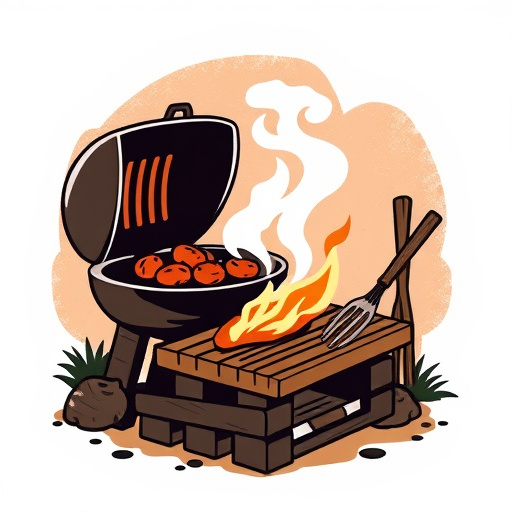To achieve mouthwatering BBQ beef ribs, select meaty bone-in cuts with a substantial fat cap, and opt for St. Louis-style or baby back ribs from specialty markets. Create a powerful dry rub with salt, pepper, garlic powder, paprika, brown sugar, chili powder, and onion powder to coat and flavor the ribs during slow cooking. Employ "low and slow" techniques to break down collagen, resulting in tender, crispy-edged ribs with rich flavor. Brine ribs in salt, sugar, and spice solution for enhanced moisture and complexity before slow-cooking. Balance ribs with crisp coleslaw and creamy salads, and complement with classic BBQ sauces for a memorable BBQ beef rib recipe.
“Unleash your inner BBQ master with the ultimate guide to crafting the perfect, slow-cooked beef ribs. From selecting top-quality ribs to mastering dry rubs and brining techniques, this article covers it all. Learn the art of low and slow cooking methods for that mouthwatering, perfectly seasoned rib sensation. Discover tips on choosing the right cuts, creating a killer rub, and pairing sides and sauces to complete your BBQ masterpiece. Elevate your culinary skills with this comprehensive guide to the ultimate BBQ beef rib recipe.”
- Choosing the Right Ribs: A Guide to Quality Beef Ribs
- Seasoning 101: Crafting a Killer Dry Rub
- Slow Cooking Techniques: The Art of Low and Slow
- Brining for Maximum Moisture and Flavor
- Pairing Sides and Sauces: Completing Your BBQ Experience
Choosing the Right Ribs: A Guide to Quality Beef Ribs
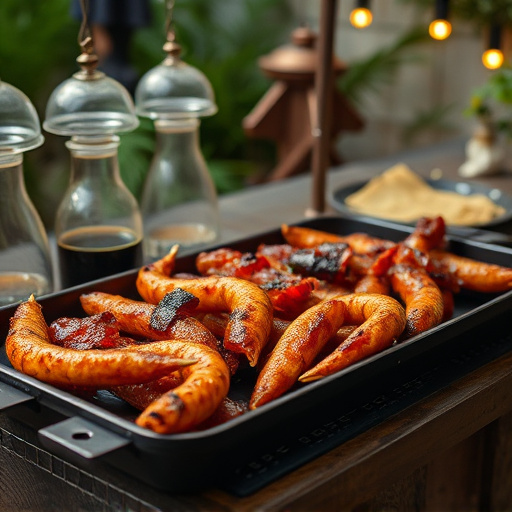
When it comes to crafting the perfect BBQ beef rib recipe, selecting high-quality ribs is the foundation for success. Look for meaty, marbled cuts with a good layer of fat cap. The ideal rib should have at least 1/2 inch (1.3 cm) of fat, ensuring moistness and flavor during slow cooking. Opting for bone-in ribs, also known as beef short ribs or plate ribs, is highly recommended. These cuts benefit greatly from low-and-slow cooking methods, allowing the meat to become incredibly tender and flavorful.
Choosing the right type of rib is key to achieving that mouthwatering BBQ texture and taste. Whether you prefer St. Louis-style, where the spare ribs are cut away from the bone in a specific way, or baby back ribs, each variety has its unique characteristics. Local butchers or specialty meat markets can guide you in selecting premium beef ribs suitable for your desired BBQ recipe.
Seasoning 101: Crafting a Killer Dry Rub
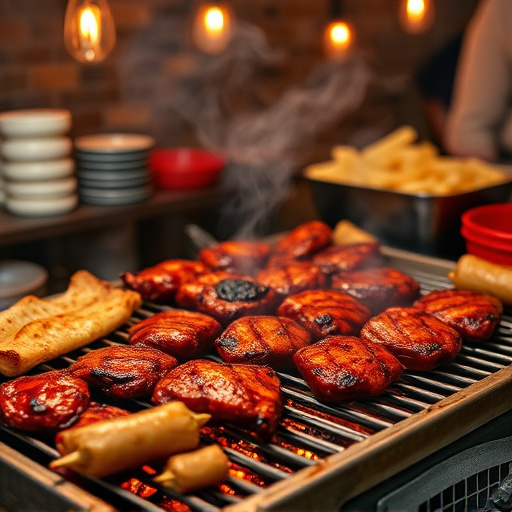
Seasoning 101: Crafting a Killer Dry Rub
The key to perfect BBQ beef rib recipes lies in the dry rub—a blend of spices that coats and infuses the meat with flavor during slow cooking. A well-crafted dry rub can transform ordinary ribs into a mouthwatering masterpiece. Start by combining a mix of salt, pepper, garlic powder, paprika, brown sugar, chili powder, and onion powder in a bowl. Adjust the quantities to suit your taste preferences; for instance, more heat from chili powder or a touch of sweetness from brown sugar. Ensure an even distribution by mixing well before applying the rub to your ribs.
For the best results, allow the dry rub to do its magic by massaging it into the meat at least 30 minutes before cooking. This step ensures that the spices penetrate the ribs, enhancing their flavor profile as they slow-cook. Whether you’re a seasoned BBQ expert or just starting out, mastering your dry rub is a game-changer for achieving tender, flavorful beef ribs every time.
Slow Cooking Techniques: The Art of Low and Slow
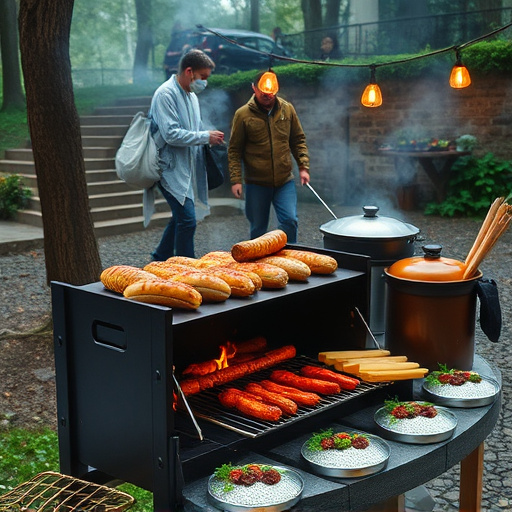
Slow cooking is an art that transforms tough cuts of meat into melt-in-your-mouth delicacies, and when applied to BBQ beef rib recipes, it’s nothing short of a culinary miracle. The method involves cooking meat at low temperatures for an extended period, allowing the heat to gently break down collagen and connective tissues, resulting in tender ribs with rich flavors. This technique is particularly suited for beef ribs, which can be quite tough due to their dense structure.
By embracing the “low and slow” approach, you unlock a depth of flavor that accelerated cooking methods struggle to achieve. The slow cooker or oven works its magic by gently rendering the fat back into the meat, keeping it moist and succulent throughout the process. This meticulous method ensures that your BBQ beef ribs are not just edible but truly exceptional, with a perfect balance between tender meat and crispy, caramelized edges.
Brining for Maximum Moisture and Flavor
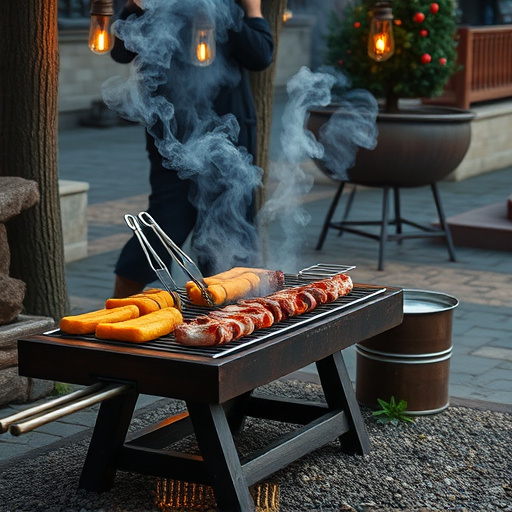
Brining is a time-honored technique used in BBQ beef rib recipes to achieve maximum moisture and flavor. By submerging your ribs in a salt and sugar solution before cooking, you not only enhance their natural juices but also infuse them with a deep, savory taste. The process starts by mixing brine ingredients like salt, brown sugar, and spices in water until well combined. Then, carefully place the ribs in the brine, ensuring they are fully submerged. Let them soak for several hours or even overnight in the refrigerator.
This brining method helps break down the collagen in the meat, transforming it into gelatin during slow cooking. The result is tender, succulent ribs that practically fall off the bone. Additionally, the spices and sugar in the brine add a complex layer of flavor that elevates your BBQ beef rib recipe to new heights. After brining, rinse the ribs gently under cold water and pat them dry before proceeding with the slow-cooking process for unparalleled taste and texture.
Pairing Sides and Sauces: Completing Your BBQ Experience
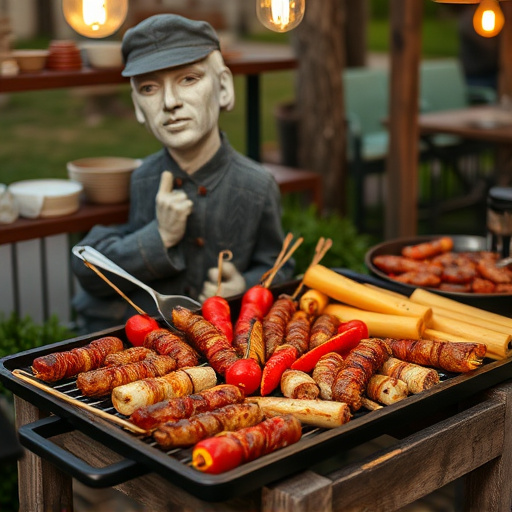
When it comes to a perfect BBQ beef rib recipe, the right sides and sauces can elevate your dining experience. Pairing your slow-cooked ribs with complementary textures and flavors is key. Consider classic options like coleslaw for that crisp crunch and a tangy kick, or opt for a creamy bean salad to balance the rich meat. Corn on the cob, grilled or boiled, adds a sweet contrast, while baked beans offer a hearty, sweet and savory complement.
Sauces are an essential part of any BBQ spread. For ribs, a simple tomato-based sauce with a hint of brown sugar can enhance their natural sweetness without overpowering. Barbecue sauces, whether homemade or store-bought, provide a smoky, tangy flavor profile that sticks to the ribs—literally! Experiment with different styles, from Kansas City’s sweet and tangy to Texas’ thick, savory varieties, to find your favorite.
